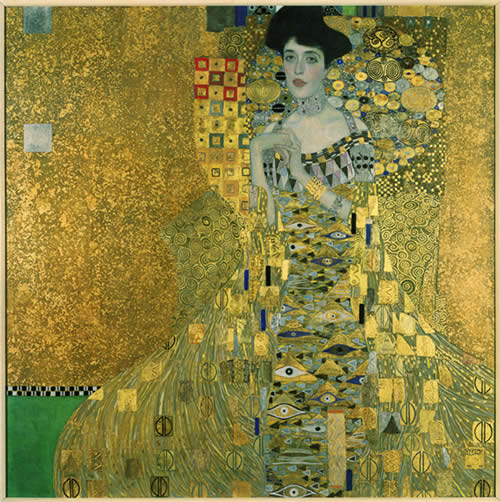The Adele Saga
It was a sixty-eight year odyssey that began when the Nazis seized the masterpiece created by Gustav Klimt in 1907, Portrait of Adele Bloch-Bauer I. The painting is deemed a 20th century icon - of gold leaf inspired by Japanese lacquer and Byzantine mosaics - and was sold in April for the highest-known price ever paid for a painting. Its sojourn is an interesting one, a saga worth telling.

Adele Bloch-Bauer I (1907) by Gustav Klimt (1862-1918); oil, silver and gold on canvas. Courtesy of Neue Galerie, New York
The turn of the twentieth century was a time of great intellectual and artistic ferment in Vienna, an era that produced Sigmund Freud, Gustav Mahler and Arnold Schoenberg, among others. Vienna, along with Paris, was the cultural capital of the world. As was the custom among the Viennese elite of that time, Ferdinand Bloch-Bauer, a wealthy Jewish industrialist, commissioned the famed artist, Gustav Klimt, to paint his young, beautiful bride, Adele. The sumptuous layers of filigree and oil make this painting highly treasured, and known to the art world as the Goldene Adele.
In 1925 at the age of forty-three, Adele died of meningitis. Her will requested that the entire Bloch-Bauer collection of five Klimt paintings be left to Austria. When the Nazis came to power in the 1930s, however, the paintings were seized. Ferdinand fled Vienna to Switzerland. Before he died in 1945, he revoked all previous wills and drafted a new one which left everything to the three children of his brother.
Six decades long, the Adele portrait hung in the Ausrtian Gallery of the Belvedere Palace in Vienna, along with two other Klimt paintings from the Bloch-Bauer collection. In 1998 Austria passed a federal law requiring that all art objects confiscated by the NS during WW II held by federal museums and collections be returned to their original owners or heirs.
Maria Altmann (90), who lives in Los Angeles and is the only surviving niece of Ferdinand’s brother, attempted via a lawsuit conducted by E. Randol Schoenberg, grandson of Arnold Schoenberg, to have them returned. After lengthy court proceedings held in Los Angeles and Vienna, representatives of both sides agreed to submit the case to an arbitration court in Austria. The court finally ruled that the conditions for restitution had been fulfilled based upon the 1998 Austrian federal law mentioned above. In late March 2006, the Adele portrait, along with other four other paintings, was returned to Mrs. Altmann and her family.
According to Maria Altmann’s wish who claimed that her aunt would have wanted the Goldene Adele portrait displayed in a museum not as a part of a private collection, the painting was sold to the Neue Galerie in New York, devoted to 20th century Austrian and German art. “We chose a museum that is a bridge between Europe and the United States,” said Mrs. Altmann.
The museum’s owner, Ronald S. Lauder (61), is the son of Estee Lauder, cosmetic magnate who died in 2004. Mr. Lauder was chairman of the Museum of Modern Art in New York for ten years and former U.S. Ambassador to Austria. For $135 million, he purchased the painting from the Bloch-Bauer family and since July gave it a permanent home in his gallery.
Since the ‘Adele’ has gone on display, the crowds have exceeded all expectation. So far, attendance has nearly sextupled, to some 10,000 visitors a week. With its overwhelming beauty and compelling story, one can hardly expect otherwise.
